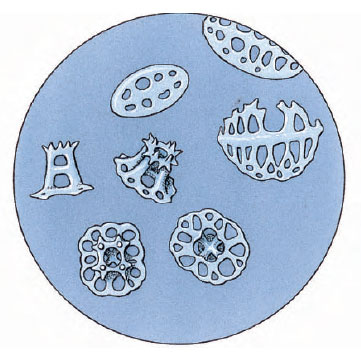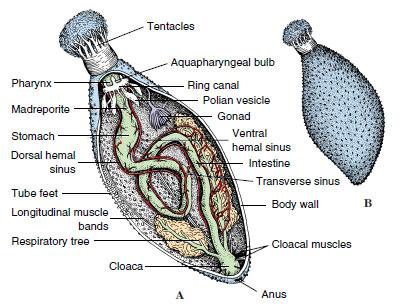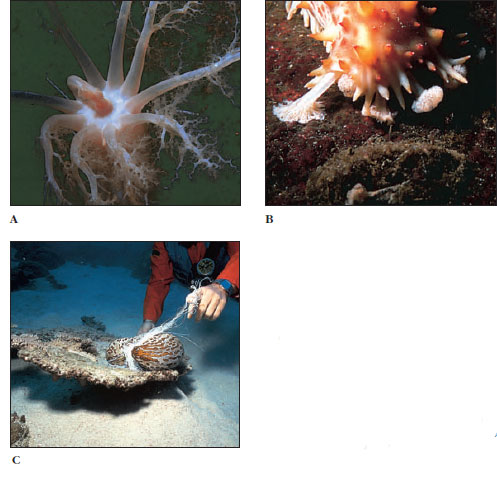Class Holothuroidea
Class Holothuroidea
In a phylum characterized by odd animals, class Holothuroidea (sea cucumbers) contains members that both structurally and physiologically are among the strangest. These animals have a remarkable resemblance to the vegetable after which they are named (Figure 23-21). Compared with other echinoderms, holothurians are greatly elongated in the oral-aboral axis, and ossicles are much reduced in most, so that the animals are soft bodied. Some species crawl on the surface of the sea bottom, others are found beneath rocks, and some are burrowers.
Common species along the east coast of North America are Cucumaria frondosa (L. cucumis, cucumber), Sclerodactyla briareus (Gr. skleros, hard, + daktylos, finger) (Figure 23-23), and the translucent, burrowing Leptosynapta (Gr. leptos, slender, + synapsis, joining together). Along the Pacific coast there are several species of Cucumaria (Figure 23-21C) and the striking reddish brown Parastichopus (Gr. para, beside, + stichos, line or row, + pous, podos, foot) (Figure 23-21A), with very large papillae.

Form and Function
The body wall is usually leathery, with tiny ossicles embedded in it (Figure 23-22), although a few species have large ossicles forming a dermal armor (Figure 23-21B). Because of the elongate body form of sea cucumbers, they characteristically lie on one side. In some species locomotor tube feet are equally distributed to the five ambulacral areas (Figure 23-21C) or all over the body, but most have welldeveloped tube feet only in the ambulacra normally applied to the substratum (Figure 23-21A and B). Thus a secondary bilaterality is present, albeit of quite different origin from that of irregular urchins. The side applied to the substratum has three ambulacra and is called the sole; tube feet in the dorsal ambulacral areas, if present, are usually without suckers and may be modified as sensory papillae. All tube feet, except oral tentacles, may be absent in burrowing forms.
The oral tentacles are 10 to 30 retractile, modified tube feet around the mouth. The body wall contains circular and longitudinal muscles along the ambulacra.
The coelomic cavity is spacious and fluid filled and has many coelomocytes. Because of the reduction in dermal ossicles, they no longer function as an endoskeleton, and the fluid-filled coelom now serves as a hydrostatic skeleton.
The digestive system empties posteriorly into a muscular cloaca (Figure 23-23). A respiratory tree composed of two long, many-branched tubes also empties into the cloaca, which pumps seawater into it. The respiratory tree serves for both respiration and excretion and is not present in any other group of living echinoderms. Gas exchange also occurs through the skin and tube feet.

The hemal system is more well developed in holothurians than in other echinoderms. The water-vascular system is peculiar in that the madreporite lies free in the coelom.
Sexes are usually separate, but some holothurians are hermaphroditic. Among echinoderms, only sea cucumbers have a single gonad, and this is considered a primitive character. The gonad is usually in the form of one or two clusters of tubules that join at the gonoduct. Fertilization is external, and the free swimming larva is called an auricularia (Figure 23-10E). Some species brood the young either inside the body or somewhere on the body surface.
Biology
Sea cucumbers are sluggish, moving partly by means of their ventral tube feet and partly by waves of contraction in the muscular body wall. More sedentary species trap suspended food particles in the mucus of their outstretched oral tentacles or pick up particles from the surrounding bottom.
They then stuff their tentacles into the pharynx, one by one, sucking off the food material (Figure 23-24A). Others crawl along, grazing the bottom with their tentacles (Figure 23-24B).
Sea cucumbers have a peculiar power of what appears to be self-mutilation but may be a mode of defense. When irritated or when subjected to unfavorable conditions, many species can cast out a part of their viscera by a strong muscular contraction that may either rupture the body wall or evert its contents through the anus. Lost parts are soon regenerated. Certain species have organs of Cuvier (cuvierian tubules), which are attached to the posterior part of the respiratory tree and can be expelled in the direction of an enemy (Figure 23-24C). These tubules become long and sticky after expulsion, and some contain toxins.
There is an interesting commensal relationship between some sea cucumbers and a small fish, Carapus, that uses the cloaca and respiratory tree of the sea cucumber as shelter.
In a phylum characterized by odd animals, class Holothuroidea (sea cucumbers) contains members that both structurally and physiologically are among the strangest. These animals have a remarkable resemblance to the vegetable after which they are named (Figure 23-21). Compared with other echinoderms, holothurians are greatly elongated in the oral-aboral axis, and ossicles are much reduced in most, so that the animals are soft bodied. Some species crawl on the surface of the sea bottom, others are found beneath rocks, and some are burrowers.
 |
| Figure 23-21 Sea cucumbers (class Holothuroidea). A, Common along the Pacific coast of North America, Parastichopus californicus grows to 50 cm in length. Its tube feet on the dorsal side are reduced to papillae and warts. B, In sharp contrast to most sea cucumbers, the surface ossicles of Psolus chitonoides are developed into a platelike armor. The ventral surface is a flat, soft, creeping sole, and the mouth (surrounded by tentacles) and anus are turned dorsally. C, Tube feet are found in all ambulacral areas of Cucumaria miniata but are better developed on its ventral side, shown here. |
Common species along the east coast of North America are Cucumaria frondosa (L. cucumis, cucumber), Sclerodactyla briareus (Gr. skleros, hard, + daktylos, finger) (Figure 23-23), and the translucent, burrowing Leptosynapta (Gr. leptos, slender, + synapsis, joining together). Along the Pacific coast there are several species of Cucumaria (Figure 23-21C) and the striking reddish brown Parastichopus (Gr. para, beside, + stichos, line or row, + pous, podos, foot) (Figure 23-21A), with very large papillae.

| Figure 23-22 Ossicles of sea cucumbers are usually microscopic bodies buried in the leathery dermis. They can be extracted from the tissue with commercial bleach and are important taxonomic characteristics. The ossicles shown here, called tables, buttons, and plates, are from the sea cucumber Holothuria difficilis. They illustrate the meshwork (stereom) structure observed in ossicles of all echinoderms at some stage in their development (×250). |
Form and Function
The body wall is usually leathery, with tiny ossicles embedded in it (Figure 23-22), although a few species have large ossicles forming a dermal armor (Figure 23-21B). Because of the elongate body form of sea cucumbers, they characteristically lie on one side. In some species locomotor tube feet are equally distributed to the five ambulacral areas (Figure 23-21C) or all over the body, but most have welldeveloped tube feet only in the ambulacra normally applied to the substratum (Figure 23-21A and B). Thus a secondary bilaterality is present, albeit of quite different origin from that of irregular urchins. The side applied to the substratum has three ambulacra and is called the sole; tube feet in the dorsal ambulacral areas, if present, are usually without suckers and may be modified as sensory papillae. All tube feet, except oral tentacles, may be absent in burrowing forms.
The oral tentacles are 10 to 30 retractile, modified tube feet around the mouth. The body wall contains circular and longitudinal muscles along the ambulacra.
The coelomic cavity is spacious and fluid filled and has many coelomocytes. Because of the reduction in dermal ossicles, they no longer function as an endoskeleton, and the fluid-filled coelom now serves as a hydrostatic skeleton.
The digestive system empties posteriorly into a muscular cloaca (Figure 23-23). A respiratory tree composed of two long, many-branched tubes also empties into the cloaca, which pumps seawater into it. The respiratory tree serves for both respiration and excretion and is not present in any other group of living echinoderms. Gas exchange also occurs through the skin and tube feet.

| Figure 23-23 Anatomy of the sea cucumber Sclerodactyla. A, Internal. B, External. Red, hemal system. |
The hemal system is more well developed in holothurians than in other echinoderms. The water-vascular system is peculiar in that the madreporite lies free in the coelom.
Sexes are usually separate, but some holothurians are hermaphroditic. Among echinoderms, only sea cucumbers have a single gonad, and this is considered a primitive character. The gonad is usually in the form of one or two clusters of tubules that join at the gonoduct. Fertilization is external, and the free swimming larva is called an auricularia (Figure 23-10E). Some species brood the young either inside the body or somewhere on the body surface.
Biology
Sea cucumbers are sluggish, moving partly by means of their ventral tube feet and partly by waves of contraction in the muscular body wall. More sedentary species trap suspended food particles in the mucus of their outstretched oral tentacles or pick up particles from the surrounding bottom.
They then stuff their tentacles into the pharynx, one by one, sucking off the food material (Figure 23-24A). Others crawl along, grazing the bottom with their tentacles (Figure 23-24B).
 |
| Figure 23-24 A, Eupentacta quinquesemita extends its tentacles to collect particulate matter in the water, then puts them one by one into its mouth and cleans the food from them. B, Moplike tentacles of Parastichopus californicus are used for deposit feeding on the bottom. C, Bohadschia argus expels its cuvierian tubules, modified parts of its respiratory tree, when it is disturbed. These sticky strands, containing a toxin, discourage potential predators. |
Sea cucumbers have a peculiar power of what appears to be self-mutilation but may be a mode of defense. When irritated or when subjected to unfavorable conditions, many species can cast out a part of their viscera by a strong muscular contraction that may either rupture the body wall or evert its contents through the anus. Lost parts are soon regenerated. Certain species have organs of Cuvier (cuvierian tubules), which are attached to the posterior part of the respiratory tree and can be expelled in the direction of an enemy (Figure 23-24C). These tubules become long and sticky after expulsion, and some contain toxins.
There is an interesting commensal relationship between some sea cucumbers and a small fish, Carapus, that uses the cloaca and respiratory tree of the sea cucumber as shelter.




